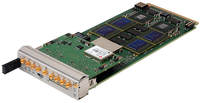
Complete RF to L3 Base Station (BTS) functionality based on Octasic 2224W DSPs, Analog Devices AD9361 RF and NXP QorIQ LS1043A quad-core ARM processors
Applications include: SIGINT, Private Networks, Public Safety, Cell Phone Control, Signal Detection Analysis and Jamming
The NAMC-ODSP-W is aimed at LTE, LTE Advanced and 5G systems that require MIMO technologies and enables complete RF to Layer 3 wireless basestation functionality to be implemented on a compact, single-wide AdvancedMC module.
Combining four RF channels with DSP, FPGA and ARM based processing, this module includes a comprehensive range of software including a Linux operating system, L2/L3 stack, virtualized core network software and software defined radio PHY firmware.
A GPS antenna input on the front panel connects to GPS receiver circuitry for GPS clock synchronization. The front panel also features a control connector for an external power amplifier.
A variant of the NAMC-ODSP-W offers a dual SFP connector to the front panel to enable a CPRI link to external RF, allowing the module to be used in conjunction with third party remote radio head (RRH) solutions.
The standard variant of the NAMC-ODSP-W, with dual AD9361 RF-SoC devices, two channels of any cellular standard can run independently of each other. In the NAMC-ODSP-W variant with dual SFP connectors, each DSP will function independently, therefore the NAMC-ODSP-W can run up to two separate cellular channels of any cellular standard and use CPRI links to communicate with remote radio modules such as the NAMC-SDR.
The NAMC-ODSP-W can be packaged in a chassis as small as the NATIVE-mini (260mm x 43mm x 302mm) catering for two AMC slots.
Applications include: SIGINT, Private Networks, Public Safety, Cell Phone Control, Signal Detection Analysis and Jamming
The NAMC-ODSP-W is aimed at LTE, LTE Advanced and 5G systems that require MIMO technologies and enables complete RF to Layer 3 wireless basestation functionality to be implemented on a compact, single-wide AdvancedMC module.
Combining four RF channels with DSP, FPGA and ARM based processing, this module includes a comprehensive range of software including a Linux operating system, L2/L3 stack, virtualized core network software and software defined radio PHY firmware.
A GPS antenna input on the front panel connects to GPS receiver circuitry for GPS clock synchronization. The front panel also features a control connector for an external power amplifier.
A variant of the NAMC-ODSP-W offers a dual SFP connector to the front panel to enable a CPRI link to external RF, allowing the module to be used in conjunction with third party remote radio head (RRH) solutions.
The standard variant of the NAMC-ODSP-W, with dual AD9361 RF-SoC devices, two channels of any cellular standard can run independently of each other. In the NAMC-ODSP-W variant with dual SFP connectors, each DSP will function independently, therefore the NAMC-ODSP-W can run up to two separate cellular channels of any cellular standard and use CPRI links to communicate with remote radio modules such as the NAMC-SDR.
The NAMC-ODSP-W can be packaged in a chassis as small as the NATIVE-mini (260mm x 43mm x 302mm) catering for two AMC slots.
Software
The NAMC-ODSP-W can run a variety of cellular software provided by Octasic and its trusted software partners. Octasic has developed physical layer (PHY) or Layer 1 software on the Octasic OCT2224 DSP for multiple cellular standards including GSM/GPRS/EDGE, CDMA2000, UMTS/HSPA, LTE-FDD/TDD and radio utility system (RUS). RUS is specialised software that provides network listen and RF player/recorder functionality on all cellular standards. RUS also includes a base station automatic synchronisation system (BASS) module, which can be used to synchronise the internal clock of the NAMC-ODSP-W to commercial base stations in areas that GPS and external clock sources are not available.
Trusted partners of Octasic and N.A.T. offer higher layer protocol stack (Layer 2/3) and core network software for GSM/GPRS/EDGE, CDMA2000, UMTS/HSPA and LTE-FDD/TDD. All protocol stacks and core network software can run on the NXP ARM processor on the NAMC-ODSP-W or on external x86 or ARM CPUs. All software layers (L1/2/3 and core) are fully integrated and can be delivered as a turn-key solution. The integrated solution can be used in various scenarios such as private networks, wireless surveillance and research and development.
More information.
The NAMC-ODSP-W can run a variety of cellular software provided by Octasic and its trusted software partners. Octasic has developed physical layer (PHY) or Layer 1 software on the Octasic OCT2224 DSP for multiple cellular standards including GSM/GPRS/EDGE, CDMA2000, UMTS/HSPA, LTE-FDD/TDD and radio utility system (RUS). RUS is specialised software that provides network listen and RF player/recorder functionality on all cellular standards. RUS also includes a base station automatic synchronisation system (BASS) module, which can be used to synchronise the internal clock of the NAMC-ODSP-W to commercial base stations in areas that GPS and external clock sources are not available.
Trusted partners of Octasic and N.A.T. offer higher layer protocol stack (Layer 2/3) and core network software for GSM/GPRS/EDGE, CDMA2000, UMTS/HSPA and LTE-FDD/TDD. All protocol stacks and core network software can run on the NXP ARM processor on the NAMC-ODSP-W or on external x86 or ARM CPUs. All software layers (L1/2/3 and core) are fully integrated and can be delivered as a turn-key solution. The integrated solution can be used in various scenarios such as private networks, wireless surveillance and research and development.
More information.
